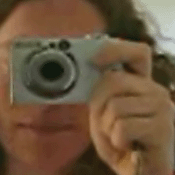 |
|
 |
 |
 |
 |
 |
  |
œuvre 2
Minute Library, by Johanna Marxer (Germany), 2005
 Johanna Marxer, an artist based in Munich, spent half a year documenting the minutiae of her life, and the life she observed, while in Germany and on a Fulbright scholarship to San Francisco.
Most days, she posted a one-minute-long video; the collected shorts are called the Minute Library.
The library is broken into past (an archive of her entries), present (the most recent video: now that the project is over, forever the 28th of October, 2005), and future (a shifting palette of German and English words and phrases: ideas for later works).
It is in the past that we find the bulk of the project; indeed, with about 130 minutes of video, cumulatively the piece reads as a feature-length film diary, with experimental tendencies - an honest David Holzman's Diary (1967), a linear The Man Who Could Not See Far Enough (1981).
Johanna Marxer, an artist based in Munich, spent half a year documenting the minutiae of her life, and the life she observed, while in Germany and on a Fulbright scholarship to San Francisco.
Most days, she posted a one-minute-long video; the collected shorts are called the Minute Library.
The library is broken into past (an archive of her entries), present (the most recent video: now that the project is over, forever the 28th of October, 2005), and future (a shifting palette of German and English words and phrases: ideas for later works).
It is in the past that we find the bulk of the project; indeed, with about 130 minutes of video, cumulatively the piece reads as a feature-length film diary, with experimental tendencies - an honest David Holzman's Diary (1967), a linear The Man Who Could Not See Far Enough (1981).
Each minute is formally rigorous: all, of course, sixty seconds; all to do with one subject and with diegetic sound; most single takes drawn from a limited spectrum of camera positions and movements (static ground level being the most common). Within these parameters, certain preoccupations emerge. The most fundamental is a feeling for children and the childlike, which often verges on a Romanticist privileging. Children are seen exiting schools, playing in the park, and messing about with toys; Marxer, too, delights in toys, and some of her best shorts involve simply that: a top spinning, a wind-up toy jumping, a ball bouncing. In one minute, a procession of children lead a cavalcade of toy vehicles, each leashed to the next; in another, two kids playing soccer bounce their ball directly into Marxer's camera. It is one of the only times you hear her laugh; you never hear her speak.
She is interested in the natural world: in forests, spiral shapes, and water; but also in organic rhythms found in inorganic constructs: in escalators, bicycles, and water faucets. (Audaciously, Marxer at one point aims for a DIY version of Michael Snow's La Région Centrale (1971), spinning her camera madly in the woods.) In their daily juxtaposition, somehow these disparate elements find commonality, and what is mundane is made compelling. In fact, Marxer finds the profound in the prosaic everywhere she goes, and she has a particular gift for making meditative the dullest household duties, from frying an egg to vacuuming.
It is in these domestic chores that one finds whatever trajectory there may be in the Minute Library. As the films progress, and the seasons change, propinquity surfaces: Marxer brings the viewer deeper into her home. In the last month, we see her buy groceries, check her email, and take a shower. In her final minute, which I watched one year, to the day, after she shot it, Marxer holds her digital camera up to her tripartite bathroom mirror. There, with the camera partially obscuring her, she adjusts, fiddles, grimaces, and smiles: we have heard her laugh, but now, we see her face for the first time. As the seconds run out, she takes the camera away and looks to the viewer, vaguely pleased, and with intimations of valediction, before the video fades out.
Patrick Ellis

 haut de page haut de page
 retour retour
|
|
 |
 |
 |
|
